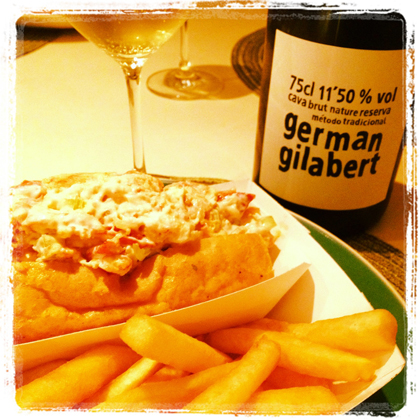Lobstah and a surprising cavah
 During the recent, week-long power outage, we sought refuge in an undisclosed location that may or may not have been the Commonwealth of Massachusetts. We found a bottle of “brut nature” cava German Gilabert (about $15; find this wine) at a local wine shop and got some lobstah rolls. This is hipster cava with a secondary fermentation in the bottle, six bar of pressure, no dosage and overall a very solid match!
During the recent, week-long power outage, we sought refuge in an undisclosed location that may or may not have been the Commonwealth of Massachusetts. We found a bottle of “brut nature” cava German Gilabert (about $15; find this wine) at a local wine shop and got some lobstah rolls. This is hipster cava with a secondary fermentation in the bottle, six bar of pressure, no dosage and overall a very solid match!
Interestingly, a little of the cava remained in the bottle and I left it on the counter. A couple of days later, I poured it in a glass and was surprised it was bubbly! I tasted it and it showed no signs of deterioration.
I asked the wine’s importer, Jose Pastor, via email for his thoughts on why this bottle held up so well. He was puzzled by the persistence of the bubbles, pointing out that he likes to decant many (grower) Champagnes and that reduces the fizz. As to the lack deterioration, he said that many of the (natural) wines from his portfolio often actually show better after being open a couple of days.
As several small producers in Champagne are making their bubbly more wine-like with less fizz, perhaps giving sparkling wines some air and serving in wine glasses will be a good way to go. What have you found in your experiments in giving bubbly some air?




On November 11th, 2011 at 10:52 am ,The Sediment blog wrote:
My routine is to get the product down to a hairsbreadth above absolute zero, and what do I find but a nice prickly mousse, followed by a hint of burnt caramel on the tongue, then a ferocious poof as it expands rapidly across the floor of the mouth like a CO2 fire extinguisher, leaving only a chesty rasp in its wake. It passes the time very agreeably, especially when you consider what we paid.
(You can read the rest here
On November 11th, 2011 at 5:01 pm ,Mr. Zdur wrote:
I like to decant Champagne and drink it from still wine glasses. It really helps integrate the flavors and subdue dominant aromas.
On November 12th, 2011 at 5:38 pm ,Robin C wrote:
I like the bubbles.
On November 13th, 2011 at 7:13 pm ,Dave McIntyre wrote:
Well, I don’t understand that first comment, especially since I’ve never sucked on a fire extinguisher, but I do appreciate the trend toward more “wine-like” bubblies. This enhances their food friendliness, if nothing else. This is not exclusive to Champagne, but is also true of some crémants from various regions of France.
On November 15th, 2011 at 12:52 pm ,Dave Erickson wrote:
We got similar results with the Gilabert; still fizzy and pleasant to drink the next day. I’m still a fan of the flute, but I do see the benefit of decanting natural sparklers. In fact, as more and more “natural” whites make it to the table, decanting is becoming a habit. We opened an Henri Milan “Le Grand Blanc” the other night, and it needed a good hour to introduce itself to itself.